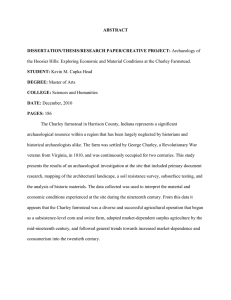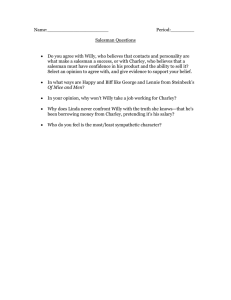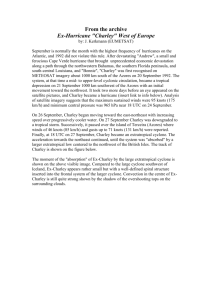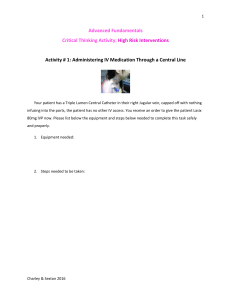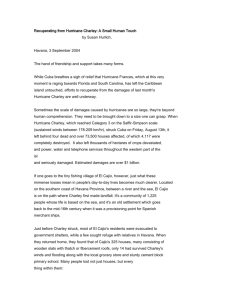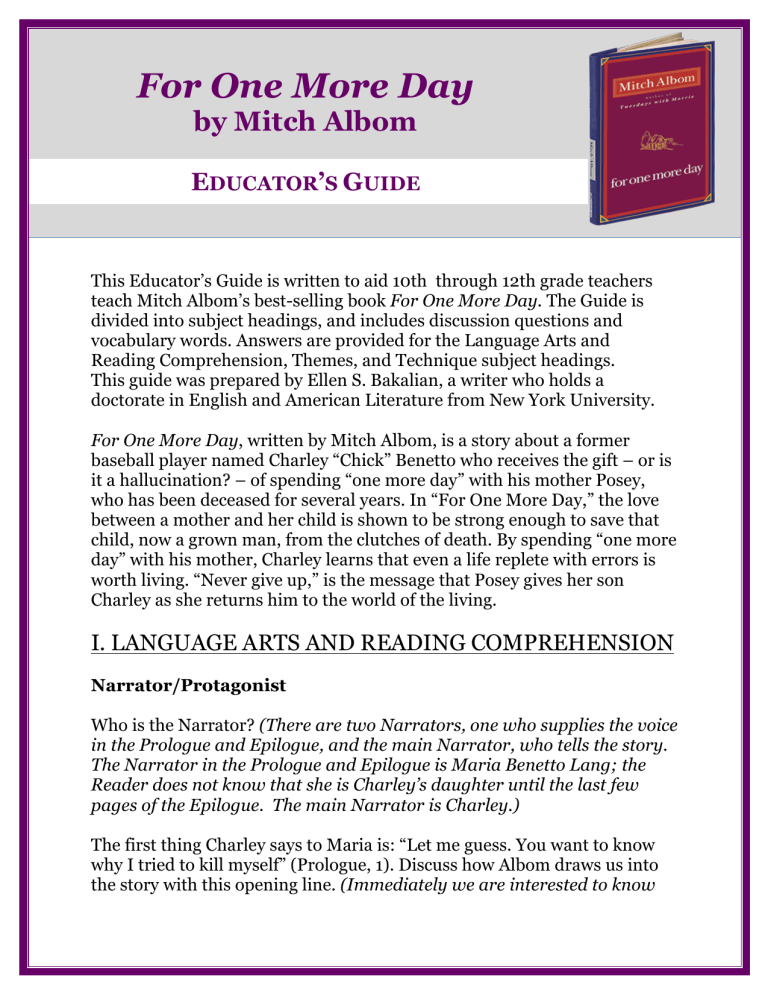
For One More Day by Mitch Albom EDUCATOR’S GUIDE This Educator’s Guide is written to aid 10th through 12th grade teachers teach Mitch Albom’s best-selling book For One More Day. The Guide is divided into subject headings, and includes discussion questions and vocabulary words. Answers are provided for the Language Arts and Reading Comprehension, Themes, and Technique subject headings. This guide was prepared by Ellen S. Bakalian, a writer who holds a doctorate in English and American Literature from New York University. For One More Day, written by Mitch Albom, is a story about a former baseball player named Charley “Chick” Benetto who receives the gift – or is it a hallucination? – of spending “one more day” with his mother Posey, who has been deceased for several years. In “For One More Day,” the love between a mother and her child is shown to be strong enough to save that child, now a grown man, from the clutches of death. By spending “one more day” with his mother, Charley learns that even a life replete with errors is worth living. “Never give up,” is the message that Posey gives her son Charley as she returns him to the world of the living. I. LANGUAGE ARTS AND READING COMPREHENSION Narrator/Protagonist Who is the Narrator? (There are two Narrators, one who supplies the voice in the Prologue and Epilogue, and the main Narrator, who tells the story. The Narrator in the Prologue and Epilogue is Maria Benetto Lang; the Reader does not know that she is Charley’s daughter until the last few pages of the Epilogue. The main Narrator is Charley.) The first thing Charley says to Maria is: “Let me guess. You want to know why I tried to kill myself” (Prologue, 1). Discuss how Albom draws us into the story with this opening line. (Immediately we are interested to know why this person tried to kill himself; secondly, we feel a connection with this character by the open and unguarded way he speaks.) Why did Charley try to kill himself? (When he wasn’t invited to his daughter’s wedding, he finally sees himself for what he is – a failure, and a drunk. His despair and self-loathing push him towards suicide.) How does the Narrator divulge important information about Charley’s life to the Reader? (The Narrator gives us insight into Charley’s life – his childhood, his disappointments, his anger, his dreams – by going back and forth between his memories, and the moments with his mother.) Do you like Charley? Why or why not? (Yes, but only because Albom writes with a familiarity which elicits sympathy and empathy towards his Protagonist. We like Charley, even though, until his conversion, he is an alcoholic scoundrel who shirks his familial responsibilities, and cannot keep a job. Talk about (in groups or as a classroom exercise) what you know about Charley’s childhood. II. THEMES 1. Family Charley’s Mother What does Charley’s relationship with his mother reveal about his character? (Charley’s mother was always there for him; she helps him to realize that he must return to his life, and reclaim a relationship with his daughter.) Who are the people Charley’s mother takes him to meet during their “One More Day” together? Why are these people important? (She visits with Thelma, the woman who cleaned their home, and who later became her housecleaning business partner. They also visit Charley’s father’s wife. Some of the people Posey visits are minor characters, but they are important because they shed light on aspects of Posey’s character that Charley does not know. ) While visiting the Italian wife with his mother, Charley whispers “I made the wrong choice” (188). Posey disagrees, saying “A child should never have to choose” (188). What are they talking about? (Charley is telling his mother that he loves and admires her, that he should have “chosen” her over his father. Posey knew that Charley was conflicted all his life between his love for his mom, and his strong desire to please his father. She knew that her husband pressured their son to ‘choose’ him as the one to imitate.) Why does Posey force her husband out of their home? (Posey discovered that he was leading a double life, complete with a second liquor store, wife, and child.) Charley’s Father Encourage your students to talk about Charley’s volatile and difficult relationship with his father. Why does Charley seek his father’s approval? (Charley continually tries to win his father’s approval because his father is so hard on him; he’s never good enough for his father, and he wants to prove his worth to him, even as an adult at the Old Timers baseball game.) What kind of man is Charley’s father? (He lives his dreams of baseball grandeur through his son. He parents by bullying his son; even when Charley is a grown man, his father bullies him into leaving his mother’s 79th birthday party to play baseball. Charley’s father turns out to be a hypocrite, and worse – he leads a double life.) 2. Divorce Learning to adjust to one’s parents divorce is difficult work, but in the 1950s, divorce carried a stigma it does not today. What happens to Charley’s family life after the divorce? (His mother is shunned, and the family’s social invitations dwindle to nothing. His mother ends up losing her job, becomes a hairdresser, and begins to clean homes, a fact Charley does not know until he meets her “for one more day.”) How does Charley feel about the divorce? (Angry at his mother, whom he feels won’t allow his father to come home.) Baseball was typically a father-son game in 1950s America. When Charley’s parents get divorced, Charley has to adjust to going to games either with his mother, or alone. How does this affect Charley? (He feels different from the other boys. He doesn’t want his mother around.) 3. Other Themes: Divide the class into groups. Ask each group to discuss one or 2 of the following themes or statements from the book: • • • • • • • love forgiveness family learning to right one’s wrongs “Sharing tales of those we’ve lost is how we keep from really losing them” (197). “You need to keep people close. You need to give them access to your heart” (194). “You can’t lose your mother, Charley. I’m right here” (191). III. SETTING Why is the novel set in a fictitious small town? Why didn’t Albom set the novel in a big city, such as New York or Los Angeles? IV. TECHNIQUE Albom quite ably stirs up his reader’s emotions. How does the author accomplish this? (Albom draws the Reader in with a familiarity that allows the Reader to identify with Charley and his experiences growing up. At several points in the novel, the Narrator asks the Reader direct questions, pulling him even further into the tale. Albom’s technique causes the Reader to wonder what it would be like to have “one more day” with someone he loves.) Albom favors short, fragmented sentences, which often begin with the conjunctions “and” or “but.” English grammar rules warn writers against beginning a sentence with a conjunction, yet Albom does it frequently. Why? Does Albom ‘get a pass’ for breaking English grammar rules? (He does it to keep the story moving and the words quickly flowing. Since Charley is narrating the story – telling it to us – Albom gets a ‘pass’ for breaking the rules.) Detail how Albom gives us insight to Charley’s life. (We are given insight into Charley’s life through both the stories he tells, and the two lists — the Times My Mother Stood Up for Me, and the Times I Did Not Stand Up for My Mother.) V. AMERICAN HISTORY AND GEOGRAPHY Charley’s father fought in World War II. When was WW II? When did the USA get involved? Charley’s father was in Italy during WWII. Locate Italy on a map. Who were our allies during WWII? VI. RELIGION AND SPIRITUALITY Imagine that Albom’s depiction of having “One More Day” is correct. Ask students to list one person they would like to spend “one more day” with, and why. Communicating with the dead is an idea which has always captured some people’s interest. Currently, there are several television shows which feature clairvoyants who promise they can communicate with the dead, and in the 19th century, séances were a popular method to talk with the deceased. Discuss the current trends. Ask your class to research 19th century Spiritualism, and compare the findings. The Narrator tells us that this story is a ghost story, a family ghost story. What does the Narrator mean by this? Discuss the following statement from the Prologue: “The dead sit at our tables long after they’re gone” (Prologue, 1). VII. BASEBALL HISTORY The game of baseball figures prominently in the book. Many of Charley’s memories are of playing baseball, and his goal in life was to be a professional ballplayer. Encourage your students to research the game of baseball, often called America’s Pastime. Report findings in front of the class. Suggested leads: When was the first baseball diamond built? Who organized the teams? Has the game itself changed much since its origins? How? When and where was Little League created? Ask students to research race and baseball: when were the first Black players allowed on the team? Who were they? How does racism play a role in baseball today? VIII. EPILOGUE Ask your students to think about Charley’s character before and after his “one more day” with his mother. Has he changed? How? What kind of a relationship does Charley now have with his daughter Maria? IX. VOCABULARY • • • • • • • • • • eccentric headstrong scandalous divert tedious recoil fraternity hi-fi séance stigma www.mitchalbom.com | /MitchAlbom | @MitchAlbom Sign up for Shelved, Mitch’s newsletter dedicated to the latest updates and giveaways at mitchalbom.com/shelved
